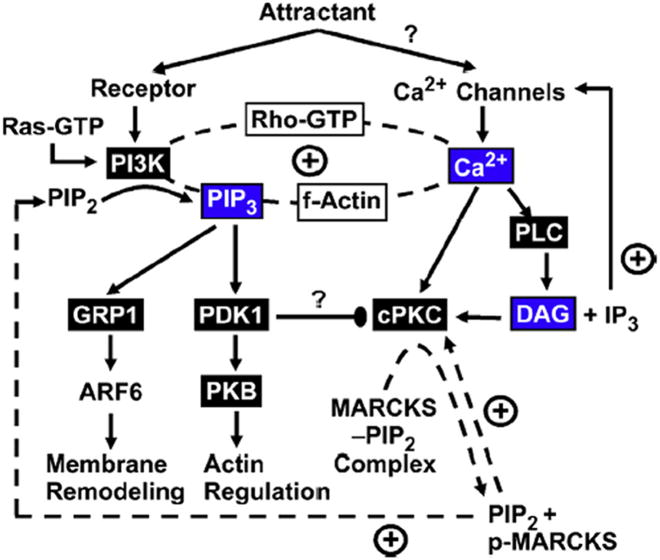Fig. 3.
Schematic, partial model of the intricate leading edge signaling circuit, illustrating known and hypothesized components and their interactions (Jin, 2013; Weiger and Parent, 2012; Cai and Devreotes, 2011; Hawkins et al., 2010; Collins and Meyer, 2009; Wei et al., 2012; Tsai and Meyer, 2012; Zamburlin et al., 2013; Henle et al., 2011; Swaney et al., 2010; Kolsch et al., 2008; Mortimer et al., 2008; von Philipsborn and Bastmeyer, 2007; Tian et al., 2010; Wei et al., 2009; Evans and Falke, 2007). Attractant signals switch on receptors and the Ras protein, which recruit and activate the lipid kinase activity of PI3K that phosphorylates the constitutive lipid PI(4,5)P2 (PIP2) to generate the signaling lipid PI(3,4,5)P3 (PIP3). Attractant signals may also activate plasma membrane Ca2+ channels that generate an essential Ca2+ influx at the leading edge. The PI(3,4,5)P3 and Ca2+ second messengers are essential players in the leading edge positive feedback loop (dashed line) along with one or more small GTPases of the Rho family, filamentous actin and PKCα. The PI(3,4,5)P3 signal recruits PDK1 to the leading edge where it is activated and stimulates branches leading to membrane and actin remodeling needed for leading edge expansion up the attractant gradient. The Ca2+ signal activates and recruits PKCα to the leading edge membrane where it is proposed to phosphorylate the PI(4,5)P2-sequestration region of MARCKS protein, which in turn is predicted to increase the free PI(4,5)P2 density and thereby activate PI3K and self-activate PKCα. Ca2+ may also activate PLC to generate a putative DAG lipid signal. Finally, PDK1 phosphorylation of PKCα in solution is essential for maturation and activation of the latter. On the membrane surface PDK1 and PKCα are hypothesized to combine and form a stable, inactive complex that could act as a brake to prevent runaway positive feedback. Proteins in boxes contain a PH domain (black box) or a C2 domain (white box). Second messengers are also highlighted (blue box).

